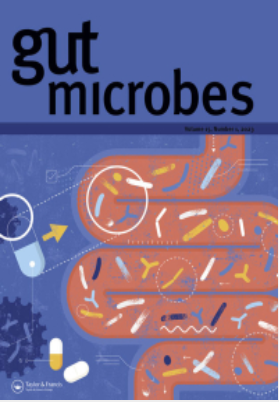Comparing Campylobacter jejuni to three other enteric pathogens in OligoMM12 mice reveals pathogen-specific host and microbiota responses.
IF 12.2
1区 医学
Q1 GASTROENTEROLOGY & HEPATOLOGY
引用次数: 0
Abstract
Campylobacter jejuni, non-typhoidal Salmonella spp., Listeria monocytogenes and enteropathogenic/enterohemorrhagic Escherichia coli (EPEC/EHEC) are leading causes of food-borne illness worldwide. Citrobacter rodentium has been used to model EPEC and EHEC infection in mice. The gut microbiome is well-known to affect gut colonization and host responses to many food-borne pathogens. Recent progress has established gnotobiotic mice as valuable models to study how microbiota affect the enteric infections by S. Typhimurium, C. rodentium and L. monocytogenes. However, for C. jejuni, we are still lacking a suitable gnotobiotic mouse model. Moreover, the limited comparability of data across laboratories is often negatively affected by variations between different research facilities or murine microbiotas. In this study, we applied the standardized gnotobiotic OligoMM12 microbiota mouse model and compared the infections in the same facility. We provide evidence of robust colonization and significant pathological changes in OligoMM12 mice following infection with these pathogens. Moreover, we offer insights into pathogen-specific host responses and metabolite signatures, highlighting the advantages of a standardized mouse model for direct comparisons of factors influencing the pathogenesis of major food-borne pathogens. Notably, we reveal for the first time that C. jejuni stably colonizes OligoMM12 mice, triggering inflammation. Additionally, our comparative approach successfully identifies pathogen-specific responses, including the detection of genes uniquely associated with C. jejuni infection in humans. These findings underscore the potential of the OligoMM12 model as a versatile tool for advancing our understanding of food-borne pathogen interactions.在OligoMM12小鼠中比较空肠弯曲杆菌与其他三种肠道病原体,揭示了病原体特异性宿主和微生物群的反应。
空肠弯曲杆菌、非伤寒沙门氏菌、单核增生李斯特菌和肠致病性/肠出血性大肠杆菌(EPEC/EHEC)是世界范围内食源性疾病的主要原因。啮齿类柠檬酸杆菌已被用于模拟小鼠肠出血性大肠杆菌感染。众所周知,肠道微生物组会影响肠道定植和宿主对许多食源性病原体的反应。近年来,研究鼠伤寒沙门氏菌、啮齿类沙门氏菌和单核增生乳杆菌对肠道感染的影响,已建立了有价值的小鼠模型。然而,对于空肠梭菌,我们仍然缺乏合适的小鼠模型。此外,实验室间数据的有限可比性经常受到不同研究设施或小鼠微生物群之间差异的负面影响。在这项研究中,我们采用了标准化的非生物OligoMM12微生物群小鼠模型,并比较了同一设施的感染情况。我们提供的证据表明,在感染这些病原体后,OligoMM12小鼠的定植和显著的病理变化。此外,我们还提供了病原体特异性宿主反应和代谢物特征的见解,强调了标准化小鼠模型在直接比较影响主要食源性病原体发病机制的因素方面的优势。值得注意的是,我们首次发现空肠梭菌稳定地定殖在OligoMM12小鼠体内,引发炎症。此外,我们的比较方法成功地鉴定了病原体特异性反应,包括检测与人类空肠梭菌感染独特相关的基因。这些发现强调了OligoMM12模型作为促进我们对食源性病原体相互作用的理解的多功能工具的潜力。
本文章由计算机程序翻译,如有差异,请以英文原文为准。
求助全文
约1分钟内获得全文
求助全文
来源期刊

Gut Microbes
Medicine-Microbiology (medical)
CiteScore
18.20
自引率
3.30%
发文量
196
审稿时长
10 weeks
期刊介绍:
The intestinal microbiota plays a crucial role in human physiology, influencing various aspects of health and disease such as nutrition, obesity, brain function, allergic responses, immunity, inflammatory bowel disease, irritable bowel syndrome, cancer development, cardiac disease, liver disease, and more.
Gut Microbes serves as a platform for showcasing and discussing state-of-the-art research related to the microorganisms present in the intestine. The journal emphasizes mechanistic and cause-and-effect studies. Additionally, it has a counterpart, Gut Microbes Reports, which places a greater focus on emerging topics and comparative and incremental studies.
 求助内容:
求助内容: 应助结果提醒方式:
应助结果提醒方式:


